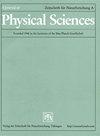Numerical simulation of a non-classical moving boundary problem with control function and generalized latent heat as a function of moving interface
IF 1.3
4区 物理与天体物理
Q4 CHEMISTRY, PHYSICAL
Zeitschrift Fur Naturforschung Section A-A Journal of Physical Sciences
Pub Date : 2023-10-13
DOI:10.1515/zna-2023-0226
引用次数: 0
Abstract
Abstract In this paper, the work is concerned with the study of moving boundary based on non-classical heat equation that includes a time dependent heat flux and convection. The latent heat is represented as a function of the moving interface. Mathematical model accounts for a control function varying with heat flux. We have obtained the explicit solution of the given mathematical model in the presence of convection and a control function. The Legendre wavelet Galerkin approach (LWGA) is used to solve the mathematical problem. In a particular case, our numerical results were compared with previous results and found to be in excellent agreement. Moreover, the current numerical technique is more efficient and accurate in comparison to the previous available method. An extensive analysis of the problem parameters is presented. It is found that the control function offers a significant contribution during the melting or freezing of a PCM. A greater value of the heat flux accelerates the rate of propagation of interface. Convection heat transfer increases the speed of the interface. Results obtained from the current study are expected to improve the fundamental understanding of heat transfer and aid in sublimation and desorption like physical phenomena.具有控制函数和广义潜热作为运动界面函数的非经典运动边界问题的数值模拟
本文研究了基于非经典热方程的运动边界问题,该方程包含了随时间变化的热通量和对流。潜热表示为移动界面的函数。数学模型解释了一个随热通量变化的控制函数。我们得到了给定数学模型在对流和控制函数存在下的显式解。采用勒让德小波伽辽金方法(LWGA)来解决这一数学问题。在一个特殊的情况下,我们的数值结果与以前的结果进行了比较,发现非常一致。与现有的方法相比,现有的数值方法具有更高的效率和精度。对问题参数进行了广泛的分析。研究发现,在PCM的融化或冻结过程中,控制函数起着重要的作用。热通量越大,界面的传播速度越快。对流传热增加了界面的速度。从目前的研究中获得的结果有望提高对传热的基本理解,并有助于升华和解吸等物理现象。
本文章由计算机程序翻译,如有差异,请以英文原文为准。
求助全文
约1分钟内获得全文
求助全文
来源期刊
CiteScore
3.00
自引率
5.60%
发文量
81
审稿时长
3.3 months
期刊介绍:
A Journal of Physical Sciences: Zeitschrift für Naturforschung A (ZNA) is an international scientific journal which publishes original research papers from all areas of experimental and theoretical physics. Authors are encouraged to pay particular attention to a clear exposition of their respective subject, addressing a wide readership. In accordance with the name of our journal, which means “Journal for Natural Sciences”, manuscripts submitted to ZNA should have a tangible connection to actual physical phenomena. In particular, we welcome experiment-oriented contributions.

 求助内容:
求助内容: 应助结果提醒方式:
应助结果提醒方式:


